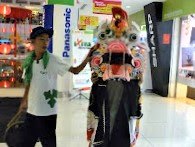My great-grandmother Rombis, a descendent of the Gomorun, married Gumpai, had five children - three daughters and two sons. Dungko (the eldest son), Gomingo, Kundipoi, Rampas (the second son) and Lotimboi, the youngest daughter.
 |
Rombis, wife of Gumpai,
my great-grandmother |
 |
Dungko Gumpai
9.9.1895 - 28.12.1999 |
 |
| Kundipoi Gumpai |
 |
Rampas Gumpai
1907 - 1966 |
 |
Lotimboi Gumpai (My maternal grandmother)
13.8.1913 - 28.1.1981 |
The Rombis family originally resided in Lumpoho. Over time, as family members began trading their produce at the tamu in Menggatal, they increasingly came into contact with the outside world. The exposure gradually sparked a desire to leave their remote homeland in search of new opportunities.
In 1926, some members of the family moved to settle in Pulutan in Menggatal. As the family continued to grow, members of the next generation began to feel that Pulutan might no longer be able to support the expanding population. This prompted them to explore new areas.
In 1936, Dungko and his brother Rampas ventured into Kiulu for the first time. Six years later in 1942, both brothers, along with their families, made the decision to permanently leave Pulutan and establish their homes in Kiulu. To ensure sustainability of the new settlement, they invited friends and relatives from Pulutan and Lumpoho to join them in this newly discovered land.
As pioneers, Dungko had the privilege of selecting some of the prime land in Kiulu - parcels located near the Tuaran River, offering spectacular views of the surrounding landscape!
Since then, Kiulu has continued to grow and develop into the vibrant community today. For their vision, courage, and effort in establishing the early foundations of this settlement, Dungko and Rampas are remembered and honoured as pioneers and founding fathers of Kiulu.
 |
| With Wesley Dungko Pai |
 |
| Beautiful Kiulu River passes by the edge of Wesley's land. |
The development of Kiulu is closely tied to the contributions of Gumpai's two sons, Dungko and Rampas. Their generosity played a pivotal role in facilitating the construction of numerous public institutions in the area. Among the enduring examples of their contributions are the Kiulu Clinic, SMK Tun Fuad Stephen (Tun Fuad Stephen Secondary School) and the row of shophouses in the township.
Dungko also served as a pastor for the Seventh-day Adventist Church (SDA) for 11 years, from 1951 to 1962. The first SDA church building was, in fact, an extension of his own home. Demonstrating his deep commitment to the church and community, he later donated part of his own land for the construction of a permanent church building, which today stands as the Malangang Lama SDA Church.
In honour of the Gomorum's ancestral root in Nunuk Ragang and to mark the founding of the new settlement in Kiulu, Dungko initiated the installation of a Memorial Stone on the very land where he first set foot. He arranged for a megalith - a large stone - to be transported from Nunuk Ragang to his own compound in Kiulu. That was no small feat, given the significant distance and the immense weight of the stone! Sadly, Dungko passed away before he could witness the completion of this meaningful project.
 |
Nunuk Ragang: 50 42’ 56.67”N, 116051’ 18.76” E
|
 |
Memorial Stone: 60 4’ 49.07”N, 115017’ 6.99” E
|
 |
Old photo of Dungko with
the memorial stone |
 |
| Current view of the memorial stone |
Dungko first married a Dusun woman named Laisa Balanda. Together, they had a son. Tragically, Laisa passed away when their son was just 7 years old. Heartbreakingly, their son also died as a teeneger at the age of 14.
Later, Dungko married Laisa's younger sister, Lasana who was 19 years his junior. Their union was blessed with nine children who survive into adulthood - five sons and four daughters: Wesley, Jainih, Joiley, Jailin, Wessie (deceased), Helen, Weldie (deceased), Widdin and Wetron.
Lasana passed away on 18 March 1982 at the age of 68. Dungko lived to a long and remarkable life, reaching the age of 104 before passing away on 28 December 1999. Both Dungko and Lasana are buried in the northwest corner of the land where Dungko first arrived after leaving Pulutan. The final resting place lies just a stone's throw from Wesley Pai's current residence.


Dungko's legacy lies not only in his role as a pioneer and community leaders in the early development of Kiulu, but also in his spiritual contributions to his people. As one of the founding figures in the establishment of the Seventh-day Adventist Church (SDA) in the region, Dungko played a key role in spreading the Christian faith among the indigenous community. Through his leadership and service, he helped lay the foundations for a faith-based way of life that continue to influence the community toady.
One of the most visible outcomes of his spiritual work is the positive transformation in the lifestyle and values of the local population. In contrast to some rural areas in Sabah, where social challenges such as alcohol abuse remain prevalent among indigenous communities, Kuilu has notably been spared from these problems to a significant extent. This distinction reflects the deep-rooted moral and cultural shift inspired in part by the teachings and examples set by Dungko and the churches he helped to establish.
It is believed that Dungko would be deeply gratified to see his effort in guiding his people toward the Christian faith continue to bear fruits. However, sustaining and expanding this legacy remains a considerable challenge. - particularly in light of the evolving sociopolitical landscape and the policies of the current government. Nonetheless, his vision remains a guiding light for those committed to preserving both the spiritual and cultural well-being of the Kiulu community.

























































.jpg)
.jpg)